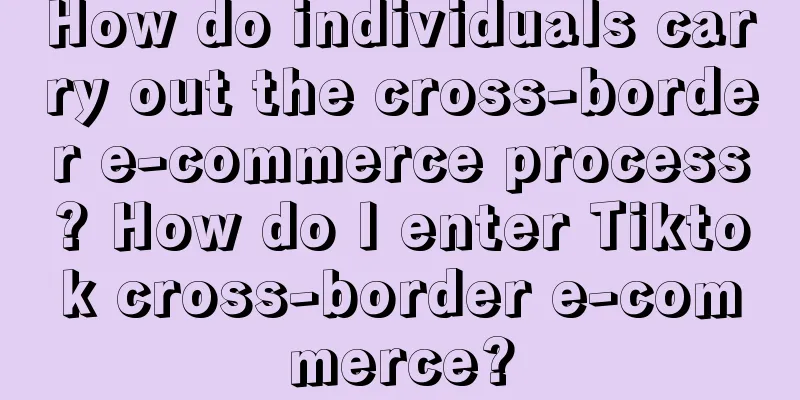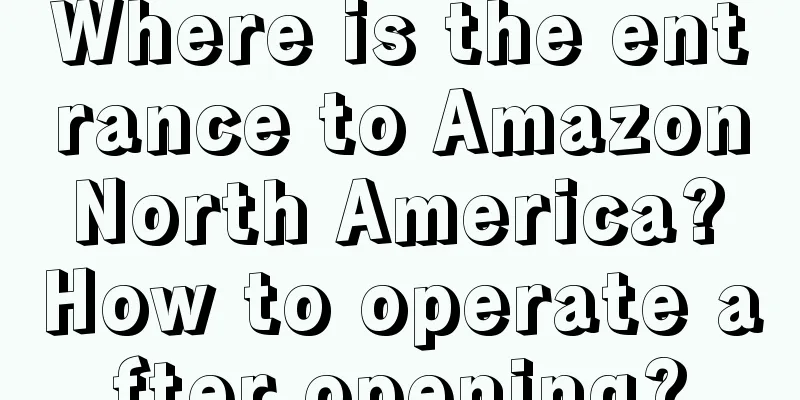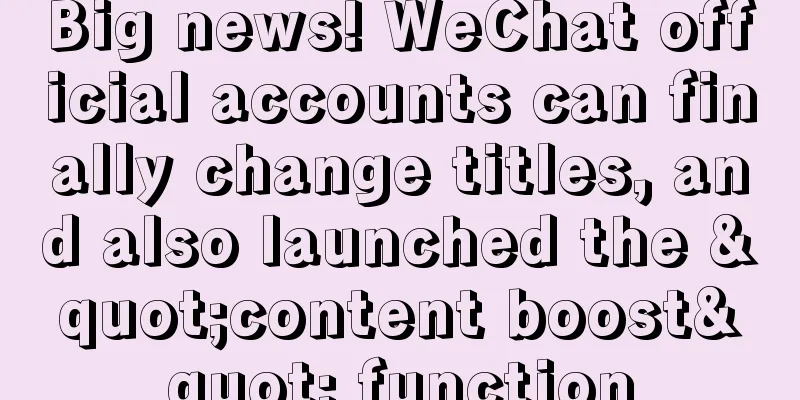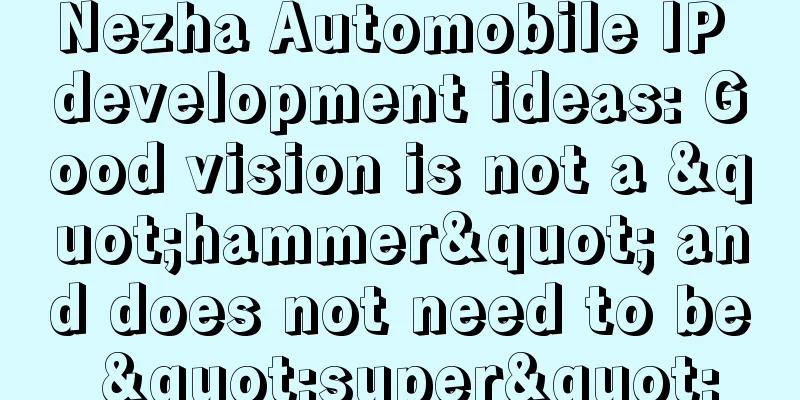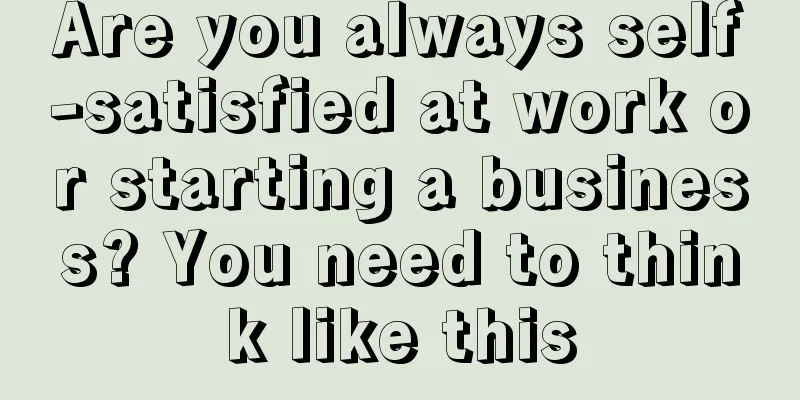Why do brands that understand marketing love to open "pop-up stores"?
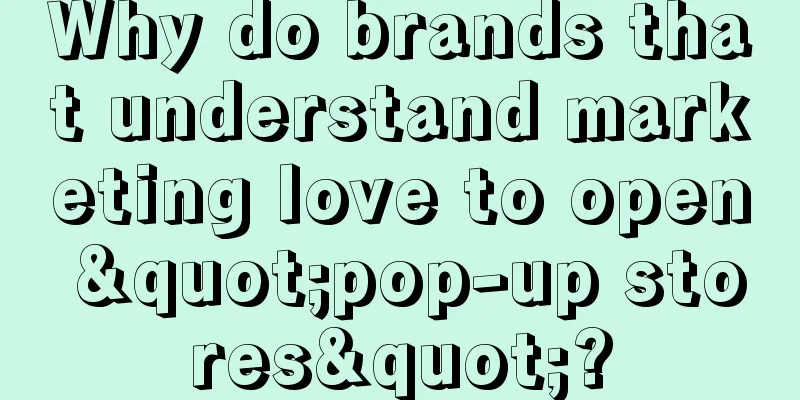
In 2023, brands are increasingly fond of opening "pop-up stores". According to incomplete statistics, more than 100 brands opened pop-up stores in the first half of the year alone. Not only brands such as clothing, catering, and beauty that are suitable for pop-up stores, but also new consumer brands such as Pop Mart, Yuanqi Forest, and Zhong Xuegao are also important participants. Even platform-based companies such as Xiaohongshu, Zhihu, and Taobao are enjoying pop-up stores. If you search for the keyword "flash store" on Xiaohongshu, there are more than 700,000 related notes. There is no doubt that pop-up stores have gradually become a "standard feature" of brand marketing. Why are brands so keen on playing "pop-up stores"? And how to play it? Through some cases, we will analyze the marketing logic behind them. 1. How popular are pop-up stores?If you like to visit popular shopping districts, you will definitely often see "pop-up stores": these pop-up stores give people a feeling of being temporarily built, with colorful decorations, which look fun and interesting, attracting a large number of young people to stop and stay. The pop-up store is actually an imported product. Its English name is pop-up store. Pop up means "flash, sudden appearance". The world's first pop-up store was created in 2003 by Russ Mille, the founder of Vacant, to help sell limited edition shoes for Dr. Martens in New York. It was later promoted by Japanese fashion designer Rei Kawakubo. In the following years, pop-up stores set off a global craze. However, the concept of "pop-up stores" did not gradually emerge in China until around 2010. After 2015, the development of domestic pop-up stores officially entered the fast lane, with an average annual compound growth rate of more than 100% . According to statistics, the transaction volume of the pop-up store industry reached 320 billion yuan in 2020, and the number of pop-up stores nationwide was about 9.6 million. It is estimated that by 2025, the transaction volume of pop-up stores will reach 200 billion yuan, and the overall scale of the pop-up store industry will exceed 800 billion yuan. It is not difficult to see from the data that the pop-up store industry has developed rapidly in recent years. Both traditional enterprises and new consumer brands are trying to launch brand pop-up stores to attract consumers' attention. At the same time, service providers specializing in pop-up store marketing planning, such as LOCATION and Lightning Space, are also quietly emerging, and the related market is constantly expanding. They rely on customer flow and business district data to provide customized marketing plans and venue information, and provide a full range of services for more brands, covering every aspect from store site selection to design and decoration. This one-stop operation service is becoming a new outlet. 2. Why do brands love to open pop-up stores?Nowadays, the development of pop-up stores is booming. From mature big brands with perfect retail channels to emerging brands that are "overtaking on the curve" in the new consumption wave, why are brands increasingly fond of opening pop-up stores? In my opinion, there are four main purposes and advantages of opening a pop-up store: to attract younger customers, to increase awareness, to boost sales, and to test responses. 1. Brand rejuvenationWith the development of the times, the emerging consumer force of Generation Z, with those born in the 1980s and 1990s as the "main force" of consumption, is leading the trend of diversified consumption. Pop-up stores are not aimed at sales, but attract and impress customers with good-looking and fun experiences. Naturally, they have become a "weapon" for traditional and emerging brands to enter the young groups. In March this year, on Maoming North Road Pedestrian Street in Shanghai, you could see a giant wearing a racing helmet and holding a Porsche 911. This was a limited-time art exhibition launched by Porsche. Obviously, Porsche's design this time was inspired by childhood racing toys, so such a design is more likely to resonate with boys. As for young people, the pop-up store approach can quickly implant the Porsche brand into the hearts of young people. When they have enough purchasing power in the future, they may become consumers of the brand. 2. Raise awarenessWith the development of the e-commerce industry, physical stores have been greatly impacted, which has also changed the consumption habits of users. Take the British vacuum cleaner brand Dyson as an example. Their survey found that more and more customers like to try offline and buy online. In order to cater to the consumption habits of users, the brand needs to open more offline stores. However, given Dyson's actual situation, it is difficult for them to do this in a short period of time. Therefore, “low-cost” pop-up stores have become the best solution to meet customer needs. In 2016, Dyson announced that it would increase its investment in the Chinese market, fully develop its offline layout, and launch a pop-up store plan. By the end of 2019, Dyson had established a network of about 800 Dyson stores covering 90 cities across the country. Dyson has successfully penetrated the Chinese market through the "store + pop-up store" model. According to Michaela Tod, president of Dyson China, Dyson's online and offline sales ratio is now as high as 5:5. 3. Boost salesAs the traffic dividend disappears, many Internet companies choose to move their marketing strategies offline. Take the "Sangcha" pop-up store created by Ele.me and NetEase News as an example. "Sangcha" is undoubtedly a leveraging of the Heytea IP, combined with the "sang culture" that resonates with young people, making the brand image more complete and attracting consumers to willingly pay for creativity. Through the coverage of hundreds of media and self-media, the total exposure of this joint pop-up store exceeded hundreds of millions. Data shows that during the event, the number of new users of Ele.me increased by 20%. In other words, by planning pop-up stores, Ele.me successfully fed back offline business to online business, driving performance growth. 4. Measure market reactionOf course, brands don’t always open pop-up stores to improve performance; it may also be a means of testing the market when transforming the brand or promoting new products. For example, during the 2017 Taobao Maker Festival, Alibaba opened a "Tao Coffee" pop-up store. This is an unmanned supermarket where you can pay without a mobile phone or wallet. It has a space of up to 200 square meters and can accommodate up to 50 people shopping at the same time. The Tao Coffee pop-up store uses biometric technology combined with mobile applications to initially realize the "unmanned payment" function. Through this pop-up store, Alibaba is also accumulating experience for the next unmanned supermarket. In addition to Alibaba, coffee giant Nestlé is also actively creating special "pop-up stores". In the context of consumption upgrading, today's consumers seem to be more willing to talk about boutique coffee or coffee shops with third spaces such as Starbucks, and instant coffee faces the risk of being eliminated. Based on this, Nestlé chose to use pop-up stores to explore the direction of future brand transformation. Nestlé opened a pop-up coffee shop called "Sense CAFE" in the Orange Hall of Sanlitun, Beijing. The shop not only provides coffee, but also the following five "feelings": sense of self, freshness, security, belonging, and accomplishment. As its market trial received wide acclaim, Nestlé Group built "Gan Cafe" into a high-end brand in 2020 and released the physical product Yunnan coffee flavor box. As mentioned above, this type of pop-up store is mostly for the purpose of testing the market, using novel scene creativity to build momentum for the official launch of subsequent products or physical stores . If the market response is flat, the brand can also turn around in time and sacrifice the pawns to save the king. 3. How to create a high-quality "pop-up store"?Of course, not all pop-up stores can achieve the expected results, and there are many examples of failure. Why are some pop-up stores so popular, while others are ignored? How should brands design a high-quality pop-up store? The following four principles can be used as a reference. 1. Layout of business districts or popular locationsFor a pop-up store, a good location is half the battle. Generally speaking, pop-up stores are located in core business districts or places with high traffic in the city. After all, the purpose of opening a pop-up store is nothing more than publicity and traffic diversion, and popularity is the prerequisite for success. Of course, if conditions permit, opening a pop-up store outdoors is also a good idea. With the continuous improvement of people's environmental awareness, exploring oneself and returning to nature is becoming a new trend. Take the American outdoor brand North Face as an example. The joint pop-up store of North Face and Kaws was opened at the foot of Tianchi Mountain in Changbai Mountain, and a special camp was built. This location not only meets the product positioning, but also conveys the spirit of active exploration of the outdoors. It can be said to be a good demonstration. 2. Integrate local culture and aesthetic preferencesAnother principle of pop-up store design is the combination of overall design style and local culture. In addition, brands need to have a deep understanding of the cultural customs and aesthetic preferences of the location where the pop-up store is located to avoid making mistakes due to insufficient research. In Chengdu, which is known as the "Land of Abundance", Dior chose low-saturation patterns that match the ancient buildings, giving the pop-up store a local flavor. In Hainan, the Dior pop-up store at the Sanya Edition Hotel is a different story. Dior adopted a blue pattern that is consistent with the swimming pool. The pop-up store is adjacent to the swimming pool and has a large number of rest areas on the side. The overall design style blends in with the tropical style of Hainan. 3. Brand elements are exposed, with strong visual impactAs a form of presentation independent of stores, pop-up stores also need to carry the core elements of the brand (such as the logo), use strong visual impact to attract consumers to the store to experience and check in, and continuously strengthen their memory of the brand symbols. Take LV as an example. In 2020, LV's pop-up store in Beijing's Sanlitun Red Hall integrated art and nature. At first glance, it looked like an art exhibition with an environmental theme. The bright colors and artistic displays provide a strong visual impact, making people want to take pictures with their mobile phones as soon as they enter the door. If you look closely, you will find that both the plant-shaped LOGO on the wall and the iconic LV print on the carpet reveal the core elements of the brand. It is these design ingenuities that enable LV to continuously capture the minds of users and further strengthen consumers' memory of the symbol. 4. Set up check-in gifts to improve user experienceThe famous "peak-end effect" emphasizes that people can often only remember two parts of their impression of an event: one is the strongest moment during the experience, and the other is the feeling at the end of the activity. IKEA cleverly took advantage of this by setting up 1 yuan ice cream at the exit, allowing customers to give their trip 5-star reviews. For brands, the setting of pop-up stores can also follow the "peak-end effect". The user's tour experience can be enhanced by setting check-in points, small games or preparing commemorative gifts. Take the Miss Sixty x ANDRÉ SARAIVA pop-up store in Chengdu IFS Plaza as an example. The brand prepared a number of check-in/game sessions for this pop-up store, including art graffiti, street skateboarding, music fitting rooms, etc., which perfectly captured the hearts of girls. This also makes this special pop-up store not only "good-looking" but also "fun"! Of course, if a pop-up store wants to "stand out", in addition to following the above four principles and winning by surprise in the design stage, the brand's own hard power is also a prerequisite for success. Only by combining products and marketing can the biggest wave be achieved. 4. Final ThoughtsToday, pop-up stores are no longer just "temporary sales points" set up by brands to increase sales or engage in hunger marketing. Instead, they are more about conveying brand concepts and enhancing customer connections. For brands, only by truly understanding target customers, combining the brand’s own conditions and advantages, and setting up marketing interactions that are in line with the brand’s tone, can they more accurately meet consumers’ tastes and create a pop-up store that is “unforgettable”. Author: Yan Tao Source: WeChat public account "Yan Tao Sanshou (ID: yantao-219)" |
Recommend
Shopee Advertising Incentive Program for January 2023
Shopee's January 2023 advertising incentive pl...
Tea drinks also won 9.9, the current situation of tea drink track: each has been leading the trend for several years
Through its unique marketing strategy and precise ...
With a fan increase of nearly 3 million in one month, what stories from the Northeast did Sister Yu from the Northeast tell?
How did the newly-rising Internet celebrity Dongbe...
How often should Amazon listings be optimized? How long does it take to see results after optimization?
On the Amazon platform, optimizing listings is the...
DeepSeek's analysis of the top ten e-commerce trends in 2025
"DeepSeek has insights into e-commerce trends...
With a follower increase of 2.93 million in 30 days, how did Luckin Coffee and Mixue Ice City become traffic black holes?
In the current fierce competition in the tea and c...
Overseas short video marketing: How to calculate audience engagement rate?
With the rise of social media and digital marketin...
Young people gather on Xiaohongshu
In the world of social media, traffic is often kin...
How much commission do new Amazon operators usually get? Is the salary high?
There are still many merchants in China who sell o...
New product launch, a must-answer question in the marketing circle in 2024
On average, a new product is launched in the Chine...
What does it mean that withdrawals from Shopee official wallet are still being processed?
The Shopee platform is very popular among consumer...
The easiest person to make money on Douyin
There are many ways to make money. You must have h...
N "specialization strategies" to help you escape competition
The specialization strategy is also called the con...
Is it really a false proposition that local life aims at promoting products?
Meituan’s latest “Local Food” feature is regarded ...
The key logic of brand building
This article analyzes the key logic of brand build...


